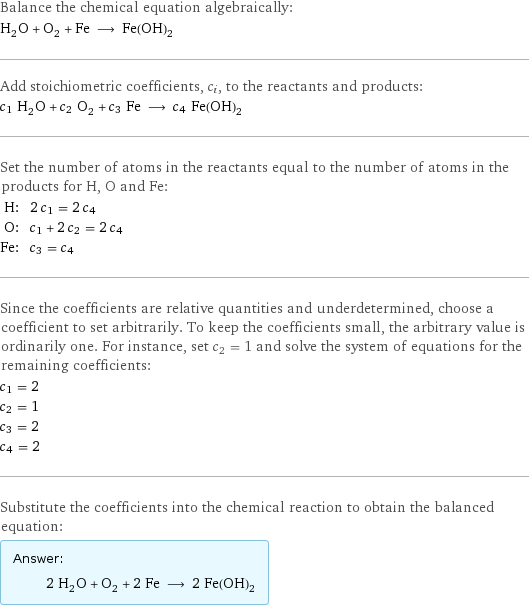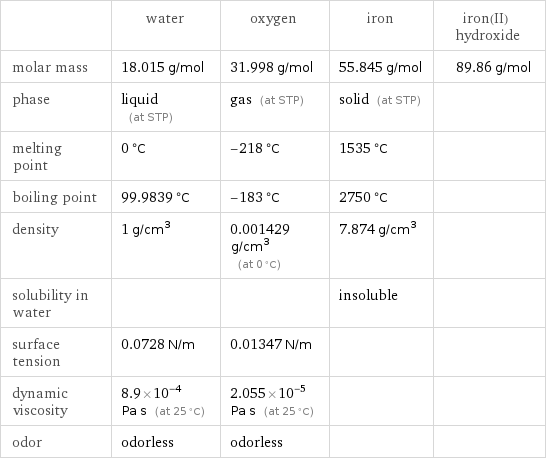Input interpretation

H_2O water + O_2 oxygen + Fe iron ⟶ Fe(OH)_2 iron(II) hydroxide
Balanced equation

Balance the chemical equation algebraically: H_2O + O_2 + Fe ⟶ Fe(OH)_2 Add stoichiometric coefficients, c_i, to the reactants and products: c_1 H_2O + c_2 O_2 + c_3 Fe ⟶ c_4 Fe(OH)_2 Set the number of atoms in the reactants equal to the number of atoms in the products for H, O and Fe: H: | 2 c_1 = 2 c_4 O: | c_1 + 2 c_2 = 2 c_4 Fe: | c_3 = c_4 Since the coefficients are relative quantities and underdetermined, choose a coefficient to set arbitrarily. To keep the coefficients small, the arbitrary value is ordinarily one. For instance, set c_2 = 1 and solve the system of equations for the remaining coefficients: c_1 = 2 c_2 = 1 c_3 = 2 c_4 = 2 Substitute the coefficients into the chemical reaction to obtain the balanced equation: Answer: | | 2 H_2O + O_2 + 2 Fe ⟶ 2 Fe(OH)_2
Structures

+ + ⟶
Names

water + oxygen + iron ⟶ iron(II) hydroxide
Equilibrium constant
![K_c = [Fe(OH)2]^2/([H2O]^2 [O2] [Fe]^2)](../image_source/4bd6cdaa8988521917521a1b68b9c547.png)
K_c = [Fe(OH)2]^2/([H2O]^2 [O2] [Fe]^2)
Rate of reaction
![rate = -1/2 (Δ[H2O])/(Δt) = -(Δ[O2])/(Δt) = -1/2 (Δ[Fe])/(Δt) = 1/2 (Δ[Fe(OH)2])/(Δt) (assuming constant volume and no accumulation of intermediates or side products)](../image_source/8aec19d76c9bb7bfe305c8c96df39986.png)
rate = -1/2 (Δ[H2O])/(Δt) = -(Δ[O2])/(Δt) = -1/2 (Δ[Fe])/(Δt) = 1/2 (Δ[Fe(OH)2])/(Δt) (assuming constant volume and no accumulation of intermediates or side products)
Chemical names and formulas

| water | oxygen | iron | iron(II) hydroxide formula | H_2O | O_2 | Fe | Fe(OH)_2 Hill formula | H_2O | O_2 | Fe | FeH_2O_2 name | water | oxygen | iron | iron(II) hydroxide IUPAC name | water | molecular oxygen | iron | ferrous dihydroxide
Substance properties

| water | oxygen | iron | iron(II) hydroxide molar mass | 18.015 g/mol | 31.998 g/mol | 55.845 g/mol | 89.86 g/mol phase | liquid (at STP) | gas (at STP) | solid (at STP) | melting point | 0 °C | -218 °C | 1535 °C | boiling point | 99.9839 °C | -183 °C | 2750 °C | density | 1 g/cm^3 | 0.001429 g/cm^3 (at 0 °C) | 7.874 g/cm^3 | solubility in water | | | insoluble | surface tension | 0.0728 N/m | 0.01347 N/m | | dynamic viscosity | 8.9×10^-4 Pa s (at 25 °C) | 2.055×10^-5 Pa s (at 25 °C) | | odor | odorless | odorless | |
Units
